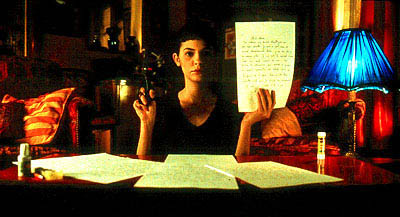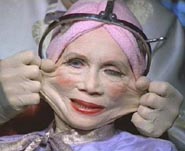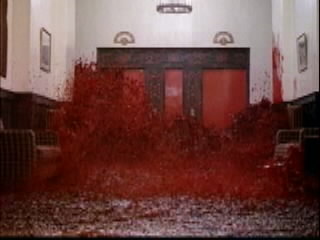Colorless Colorfulness: Gilliam & Jeunet's Cinema


Until fairly recently, artists and art critics have viewed color as a secondary mode of expression, associating it with superficiality and instability. In the nineteenth century, realist painters contained color within the boundaries of line, arguing that this is the natural order of things. In the 1940s and ‘50s, realist filmmakers tended to use black and white for its associations with rawness, grittiness, and “the real.” David Batchelor has called this history one of “chromophobia,” wherein artists and critics fear color for its associations with the foreign, the superficial, and the unstable.
While this history has recently been challenged in cinema by a diverse group of “chromophiles” like Pedro Almodovar, Paul Thomas Anderson, Claire Denis, Hou Hsiaou-hsien, and Lukas Moodysson, who use color in liberating cinematic ways that favor abstraction, diversity, and the proliferation of meanings, it must also be noted that color has been co-opted by certain filmmakers as a kind of cinematic shorthand. In particular, Terry Gilliam and Jean-Pierre Jeunet, both auteurs who have become popular with young cinephiles, tend to use garish color to create a new kind of institutionalized “great cinema.” That is to say, both filmmakers, coming off the heels of Stanley Kubrick, have defined for modern audiences what cinematography and mise-en-scene “should look like,” but in the process have begun to contain the proliferation of meanings so that what results is a static enterprise of colorless colorfulness.
Take Gilliam’s Brazil or Jeunet’s Amélie. Neither of these films are realist. Brazil is explicitly set in a hypothetical sci-fi universe and Amélie is set in the lead character’s imaginative mind. Therefore, color can be used in ways that do not have to be explained by the laws of our universe, as when red and blue lights flash on and off in Sam’s apartment in Brazil for no apparent reason other than the aesthetic impression it creates for the ambience of a sci-fi movie. Or in Amélie, which depicts the Reine as far more green than it actually is.

So if these films aren’t realistic, could their use of color be trying to do something more psychological or abstract? Unfortunately not. If you attempt to read the colors in Brazil or Amélie for any kind of abstract meanings, all you get are contradictions – does Gilliam mean to demonize techno-bureaucracy with drab grays and whites, or does he mean to demonize the superficiality of cosmetics (Sam’s mother) with garish colors? Does Jeunet mean to create a contrast between Amélie’s red warmth and the coldness of green Paris, and if so why does Amélie sometimes wear green?
Perhaps this kind of incoherence is precisely the rejection of stable meanings that Batchelor is calling for. The trouble with this view is that Brazil’s and Amélie’s use of color is not so much a proliferation of meanings as it is a void of meaning. Unlike films like Punch-Drunk Love, which use extra-diegetic film techniques to incorporate color abstraction into the narrative so as to create a rich set of contradictory meanings, Brazil and Amélie contain color within the plot, and only use it for aesthetic purposes. That is to say, because it looks good.
In film history, certain aesthetic techniques often take on associations as either the savior or bane of cinema’s existence. Cinephiles have long revered the long take, CinemaScope, and angular shots, a set of preferences that has served to canonize figures like Jean Renoir, Orson Welles, Max Ophüls, Nicholas Ray, Federico Fellini, Robert Altman, and Martin Scorsese. With 2001: A Space Odyssey, A Clockwork Orange, Barry Lyndon, and The Shining, Stanley Kubrick added color and anamorphic symmetry to the list of cinephilic preferences.
Having apparently internalized these preferences, Gilliam and Jeunet continue in this tradition. Brazil continuously uses low angle shots that emphasize angularity and depth, as well as omniscient aerial shots that break the boundary of ceilings. Gilliam’s favorite framing device is to have one subject extremely close to the camera on one side of the frame, and one or two other subjects further in the background. This creates depth, but it also serves to distort the extremely close figure’s face into a realm of absurdity, evoking Fellini’s 8 ½. Another signature device in Brazil is the use of smooth tracking and crane shots, constantly moving. Amélie also employs tracking shots, often to introduce characters who stand in the center of the frame and look towards the viewer, as well as framing devices that emphasize depth and distortion. What Jeunet adds to this tradition is a computerization of the smooth tracking shot. In a sense, this is the logical extension of the perfectionism of figures like Welles, Kubrick, and Gilliam. Now, the camera can be unequivocally steady because shots can be constructed through CG, as with the shot in Amélie that highlights three words on a note: LOST BAG PHOTOS. This is a device that has been used elsewhere by David Fincher, although Fincher tends to use it as part of a thematic gimmick. Jeunet uses it for pure aesthetic reasons: to look good.

Since the elevator unloaded several thousand pints of blood in Kubrick’s The Shining, there has been a cinephilic lust for surrealism. Both Brazil and Amélie bask in a certain kind of arbitrary surrealism. I say arbitrary because it is not rooted in the politics of a Bunuel or Dali, but rather in an aesthetic preference. The reds and blues that flash in Brazil are part of a surrealist agenda that has no purpose. Similarly, when Amélie drops a perfume cap onto the bathroom floor, the tiles are a checkered yellow and green, and the image immediately conjures Dali, but for no reason other than aesthetic pleasure.
If Brazil or Amélie have any sort of political agenda, it is a conservative one. Both films valorize escaping into one’s own mind, or into the nostalgic memory of a natural environment, totally unencumbered by reality. Brazil, at least, depicts the social realities that it abhors: bureaucracy, technology, terrorism, cosmetics. Like Antonioni, Gilliam shows how technology can literally get in the way of two human beings finding one another. In Sam’s nightmare-dream, it becomes impossible to see his mystery woman as tall buildings grow into the sky. In Sam’s reality, there is a scene in which he can see Jill from an elevator, but he cannot get to her. They are separated not so much by physical distance as they are by technology. Sam is in an elevator that he cannot escape. If Brazil is grounded in social realities, it ultimately uses these realities for parody and fantasy, which Gilliam is interested in prioritizing over the realms of reason and technology.
Amélie has a similar agenda, depicting totally unreal happenings, like a blind man suddenly catching on CG fire, a giant lizard, or a winking statue. Amélie, like Sam Lowry, is a character who dreams of better realities. However, unlike Brazil, which coherently rejects techno-bureaucracy in favor of the country life, Amélie presents no conception of what Amélie rejects about her society and what she would rather have. Rather, it is about the retreat into imagination for its own sake. This point is reinforced by the painter whose lesson is to make cartoon paintings rather than recreating those of Renoir. According to this reading, garish saturated color represents the realm of the fantastic and the imagination, but there is no real reason offered for why it is necessary to escape into such a realm.
In addition to glorifying the fantastic, both Gilliam and Jeunet are interested in the infantile. Especially in films like Gilliam’s The Adventures of Baron Munchausen and Jeunet’s The City of Lost Children, there is a strong support for child-authenticity and wisdom, the myth that children somehow know better than adults. This theme carries over into Brazil’s and Amélie’s irrational and simplistic valorization of fantasy and imagination. Unlike Kubrick, who used perfectionist color and camera techniques to explore the cruelty of a deterministic universe, Gilliam and Jeunet borrow Kubrick’s sense of style for a Disney/Spielberg-esque content. Amélie, in particular, has such a facile commitment to the theme of “helping others” that it comes across as a child’s perspective on life, which is precisely what the film seems to be going for. The child’s perspective, in the sense of Occum’s Razor, is more correct: we must help others. It is the French version of Pay It Forward.
In fact, the only thing that distinguishes these films from movies like Pay It Forward is their European-ness, which is performed in due fashion. British humor is the delight of Brazil, whereas Amélie is a kind of postcard for Paris. Jeunet’s choice of colors seems finally to make sense in this light: how to depict Paris? The green-yellow motif works perfectly to capture Paris’s earthy disposition, as well as to characterize it as slightly offbeat from the red-white-blue United States, which was ultimately the film’s prime market. With hints of red, Paris is coded as an offbeat town with its heart in the right place. In conclusion: come to Paris!
The purpose of Gilliam’s and Jeunet’s cinema is to capitalize off the American youth market, which is always interested in films that are slightly quirkier than Hollywood mainstream films. Color has been one of the prime methods towards achieving commercial success in America, creating dreamscapes of garish aesthetic beauty. Along with symmetry, smooth (now computerized) tracking shots, and angularity, color has been canonized as part of a tradition towards aestheticization, perfectionism, surrealism, juvenilia, and performed European quirkiness. That is to say, Terry Gilliam and Jean-Pierre Jeunet have forwarded a cinema that has overcome its “chromophobia,” but still fears abstraction and the proliferation of meanings.
